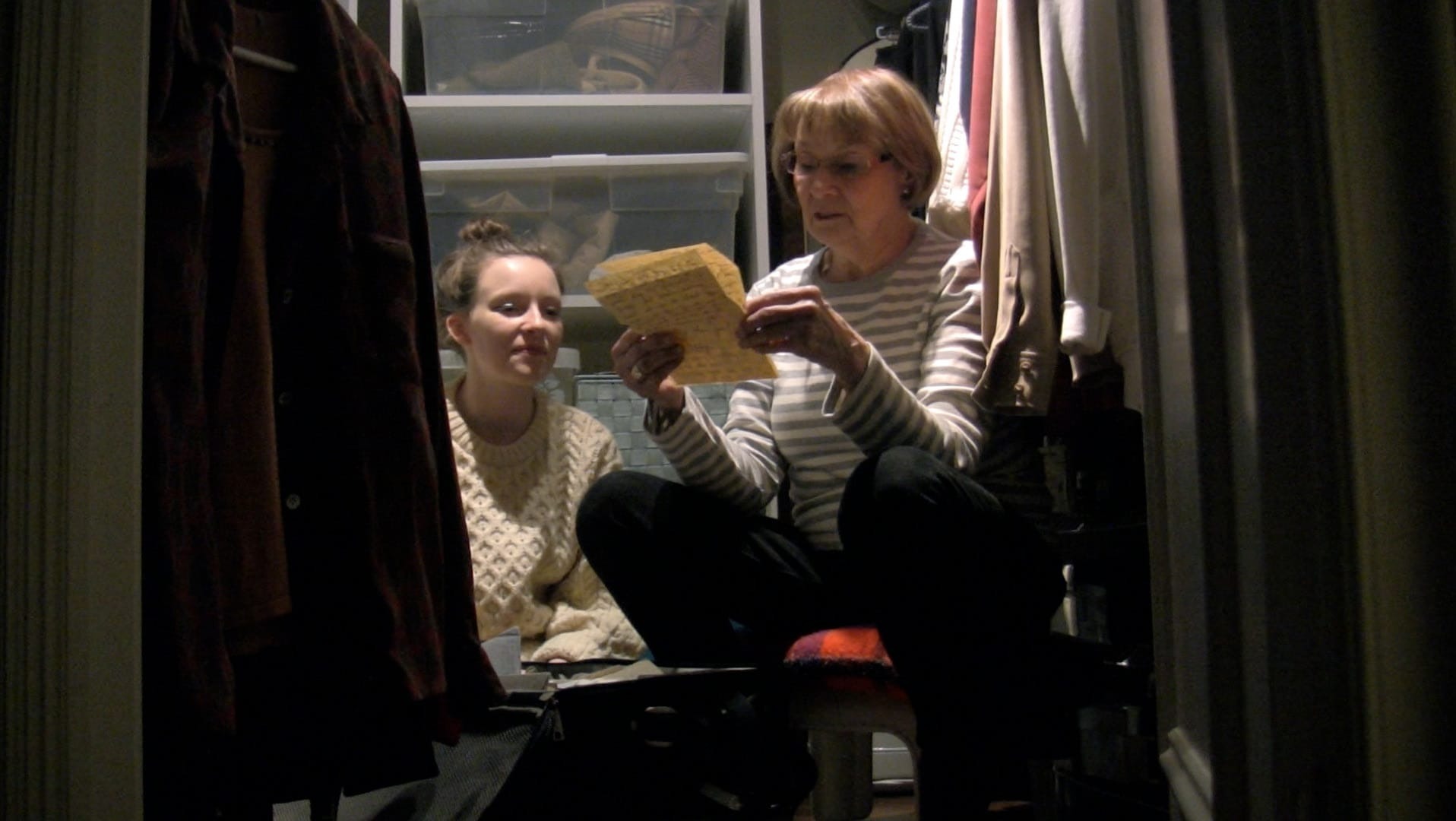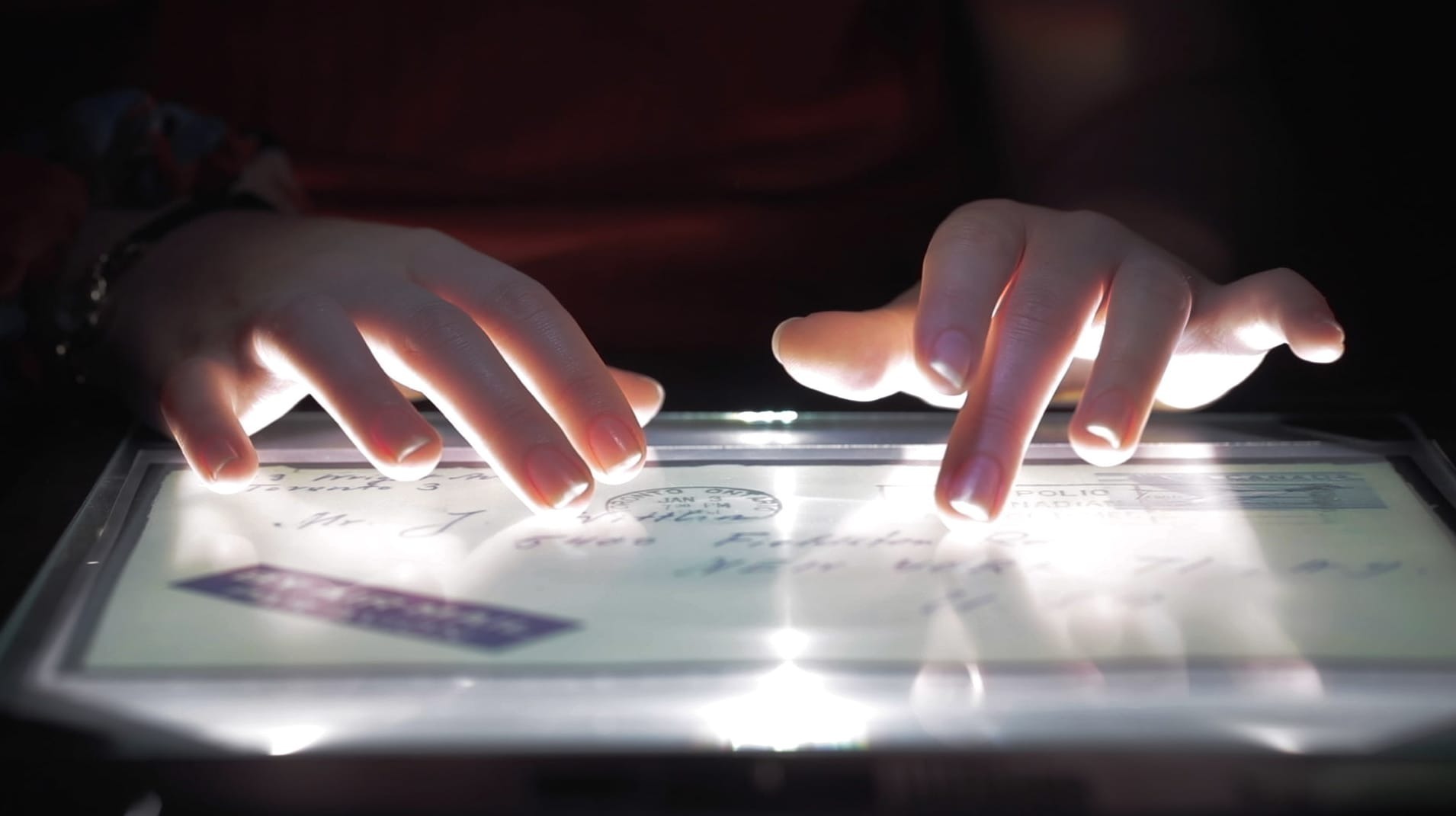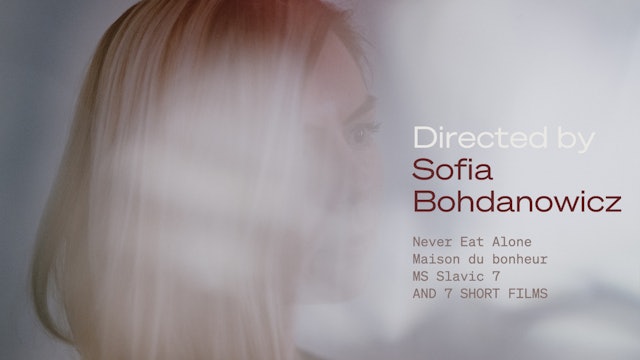Something Human: A Conversation with Sofia Bohdanowicz and Deragh Campbell

Echoes of the past reverberate throughout the films of Canadian auteur Sofia Bohdanowicz. Working as a director, writer, cinematographer, editor, and producer, frequently in collaboration with actor Deragh Campbell, she has made four acclaimed features and ten short films that are love letters to the objects and memories she holds sacred. Her style draws on documentary, fiction, essay films, and detective stories, tying these eclectic elements together with the theme of excavation. Whether exhuming her family history, reimagining the life of a Parisian astrologer, or capturing her personal process of grief, her films investigate the mysteries beneath the surface of the everyday.
In her debut feature, Never Eat Alone (2016), Bohdanowicz cast her grandmother to play a version of herself, a woman who enlists her granddaughter to help her track down a lost love. The film marked the first time Bohdanowicz teamed up with Campbell, who had earned acclaim in independent films such as Matthew Porterfield’s I Used to Be Darker. Campbell embodies the director’s alter ego, Audrey Benac, a perpetually curious woman who uncovers buried knowledge about her family. Since working together on Never Eat Alone, Bohdanowicz and Campbell have become close creative partners, cowriting and codirecting a series of shorts and features (including MS Slavic 7 and Veslemøy’s Song) centered on Audrey’s quests. Taken together, their work calls to mind the formal and intellectual rigor of Chantal Akerman and Agnès Varda, filmmakers who used cinema to discover new ways of exploring their own lives.
Reflecting on the evolution of their collaborative friendship, Bohdanowicz and Campbell both describe it as a great love story, built on the intellectual, artistic, and emotional chemistry they immediately felt when they first met each other at Toronto’s TIFF Cinematheque ten years ago. To mark the arrival of a collection of their films (as well as Bohdanowicz’s solo directorial efforts) on the Criterion Channel, I spoke with the two women about the paths that led them to each other and the artistic values they share.
Given the intimacy of your work together, I’d love to know more about what drew you to each other. Was there something you recognized in each other that felt familiar when you first met?Bohdanowicz: Toronto’s film culture has developed in such a beautiful way and now has a real sense of community, but before I’d made my own work, I had a hard time finding my place in the city’s mix of cinephiles and filmmakers. When Deragh entered the filmmaking world in Toronto, it became a lot warmer for me. Whenever I’d run into her at the cinematheque or at a party, talking to her made me feel grounded, like I had found my footing. I finally found someone who was speaking the same language and just vibrating on the same frequency that I wanted to be on. Then, when I saw her in I Used to Be Darker, I was bowled over by how incredibly talented she was and by the delicacy of her performance. I was so enamored with it that I was a little intimidated to ask if she would perform alongside my grandmother in my first feature, Never Eat Alone. I was very lucky that she accepted.
Campbell: One thing I noticed early on about Sofia—before she even invited me to work with her—was that she really cared for the lives of her films and honored them and the people who worked on them. A lot of people feel entitled to space at the biggest film festivals, but I saw that Sofia was finding new spaces for her films and making arrangements to get them seen. It wasn’t an egotistical thing; she was doing it for her films, and I found that beautiful. And when she invited me to work on Never Eat Alone, she had such amazing instincts for what needs to happen to create the environment she wants to see on-screen, which made what I had to do as a performer very clear. I quickly realized that she and I have extremely similar goals for how we want to feel around other people and how we want to make other people feel.

Sofia, given your passion for photography, writing, and other creative pursuits, how did you know filmmaking was the path you wanted to pursue?
Bohdanowicz: I got into filmmaking in a very nontraditional way. I loved going to the movies, especially the drive-in, but I wasn’t drawn to becoming a director because of one particular film or filmmaker. It was actually because I had a hard time with public speaking in high school. I would always bomb presentations, and it was so humiliating because I never felt seen or heard, and never felt that my voice was being interpreted in a way that I wanted it to be. So I started making films and fell in love with the process. I was running around my school with a camcorder, interviewing people and putting together scenes very spontaneously. But I also loved the technical process of hooking my father’s JVC camcorder to a VCR, getting dialogue from the left stereo channel, then plugging in my Discman and playing it on the right. I was obsessed with the process of editing, but I also loved being able to craft the exact message or vision that I was trying to deliver to people. It wasn’t until later that I realized filmmaking was something I could pursue as a career. I didn’t know it was a possibility.
Deragh, you started out acting but have since taken on cowriting and codirecting your collaborations with Sofia. I’m wondering if you ever envisioned yourself behind the camera before you met Sofia.
Campbell: I have an odd relationship to acting. When I think about acting, I think about family, because I come from four generations of theater actors. But I didn’t set out to become an actor—I wanted to be a novelist. I was very lucky when I was cast in my first film, I Used to Be Darker, because it was a festival film, and [Matthew Porterfield] is a cinephile. So it was almost like I was entering the world of film more than I was entering the world of acting. I’m so fascinated by the narratives of how people’s lives are built, and I find it beautiful how you can end up returning to the things you love through unexpected paths.
It’s interesting that I came into acting on my own but that my involvement with screenwriting came through my work with Sofia. That’s a testament to how she works with her collaborators and how she never limits them to one role. We cowrote MS Slavic 7, and then she brought me into the editing process and eventually gave me a codirecting credit.
Bohdanowicz: The way we were making films before—I say “before” because we’re moving into different territory with our new project—was by necessity so small because of the budgets, but I also preferred it that way. I have control behind the camera, but Deragh is not just an actor who inserts herself and says her lines and is finished. She’s thinking about the way she’s framed and if that feels real for the character. Working with someone you can trust makes working on that scale possible. Deragh has skills as a performer, a writer, and a costume designer, and someone who doesn’t have an understanding of those different practices wouldn’t be able to help guide the film in the way she does.
Something I immediately loved about your films is how tactile they are, the way the physical objects in them—whether it’s a Mozart chocolate ball or a handwritten letter— have such emotional and narrative significance. I’d love to know more about where that quality in your work comes from.
Bohdanowicz: I’m the eldest child on the paternal and maternal side of my family and was always being given historical objects and jewelry that belong to my family, so I always felt the weight of being their caretaker. The stories that I was told about them were some of the first narratives I ever knew, so they took on a lot of significance. I’ve always been interested in the Swann’s Way aspect of objects and what they can bring to your life—how they can transport you to certain moments by the way they smell or how they feel in your hand.
For me, learning to foley my own films (because there was no budget to do otherwise) really added a sense of texture and tactility. And then of course shooting on film gives everything an extra layer of materiality because of the process of working on celluloid. But that tactility is also the result of working with Deragh, who is so good at bringing those objects to life and engaging with them in interesting ways. How she plays with the letters and my great-grandmother’s cigarette case in MS Slavic 7, or the way she wears my grandfather’s clothing in Never Eat Alone . . . Those films are shot digitally, but the texture comes alive in the way that the actors emote and behave with those objects.

Campbell: Sofia and I recently visited Harvard as guests in [filmmaker] Dominga Sotomayor’s class, and Sofia did this workshop with the students that she calls the “Sacred Object” workshop. She has the students pitch their films, and then they all talk about what they think could be objects of significance in these films. Sofia is conscious of using objects as an anchor or as the heart of a film, and this method is extremely useful to me as a performer, because it gives me a point of focus. It was beautiful to see that, through this exercise, the students became more invested in each other’s work. So much of Sofia’s practice involving the idea of the object is that it’s an invitation for something to belong to other people as much as it belongs to her.
There’s also a feeling of ephemerality to these sacred objects, like the recording in Veslemøy’s Song, which is fragile and can only ever be heard once. The search your characters are on is always met with the same passion and dedication, whether they’re trying to find something they can hold in their hands or trying to find something that can only be experienced.
Bohdanowicz: I appreciate that you see that so clearly. Part of the importance of the “sacred object” thing for me is that filmmaking is very chaotic. We live in a world that changes so rapidly, that is dangerous and intense and completely unpredictable. But if you have an item or goal that centers you as you move along your way, I believe that you can make better decisions. When I made Veslemøy’s Song—a film about searching for a recording whose history is physically disintegrating—and as I was processing the film, I accidentally loaded it incorrectly in the Lomo tank, which resulted in all these crazy lines going through Deragh’s beautiful face. I was really upset about it at first, but when I looked closer, I thought, oh, this is so interesting, because the lines looked like a violin bow or the lines in a score.
If you have a goal that centers you, then when accidents happen along the way you don’t have to see them as disasters. You can think: how can this leave more of a human imprint on my film? For me, a good film is something human, and I think there’s a certain element of forgiveness or curiosity that comes out in these flaws.

Can you talk about the character of Audrey Benac? How has she evolved since she was initially conceived in Never Eat Alone, as you’ve developed her together in subsequent projects?
Bohdanowicz: Audrey is a combination of Deragh’s thoughts and reactions to experiences I’ve drawn from my family history, as well as her own ideas informed by the books she reads and the films she watches to prepare for our projects. But the starting point of Audrey in Never Eat Alone was very intimate: she’d live in my cousin’s bachelor apartment with a little Murphy bed, and she’d wear clothing that belonged to my grandmother and grandfather, as well as some of our own wardrobe.
I was impressed by how Deragh dealt with that intimacy so delicately and openly. She embraced it and took the character in as a friend, as someone she loved and developed into a human being. Audrey has such a life and breath of her own that we are able to be playful with the character and create an outline for her in different scenarios. We’re able to improvise and play a lot with her personality and gestures, and I think throughout the films you see her become a stronger combination of considerations from both of our lives—not just my family history but Deragh’s own experiences as well.
Campbell: I’ve been thinking a lot about the separation between actors and the characters we play. The way a lot of people think about acting, or a lot of the language around acting, has to do with becoming a character. But for me, it’s a little bit more like an interaction that you have with a character, a dialogue that develops between you and this fictional person. It’s through this dialogue that the character is born. My grandmother recently said to me that film sets are so much about relationships and the time you spend with the people you’re making the film with. But it’s also about the time you spend with this character and the relationship you have with them. One of the things that moves me about Audrey is her determination, her single-mindedness about her pursuit, but something that we leave unanswered on purpose is why or what it is that compels her to keep on this track. Maybe it comes from a real sense of emptiness, that she needs a pursuit in order to not feel lost.
Deragh, when discussing Stromboli in the Top 10 list that you two wrote for us a few years back, you mentioned that your “favorite kind of interplay between documentary and fiction is when a fictional character witnesses a documentary event.” I thought that was so revealing about the work that the two of you do together.
Campbell: It’s so nice that you zeroed in on that quotation, because that’s what I feel about performance: it’s about having an experience as the character and having it documented and witnessed. What the character is doing has to be enthralling enough for you to embody that, or you have to put a lot of effort into being enthralled. It’s the idea that you want to be so taken over by the experience of what your character is doing that you’re no longer making decisions about how the character would respond, you’re just responding without control of exactly what you’re signaling with your face and body. Sofia is so good at finding spaces and activities and collaborators that allow me to be fully immersed in what I’m doing.
Has your process changed as you’ve grown individually as artists and now that you both are often in different cities or countries working on projects separately?
Campbell: I’m sorry that this is becoming very sentimental, but I do feel now that when Sofia and I are in the same city, we experience a feeling of home. When we part, our goodbyes have become so tearful and extreme. And now when we work on things in separate places, there is a feeling of being away. We had to write a lot of our next film separately, though we would consciously go and be in the same city and spend time together at significant points in the process. It will be quite beautiful to be together when we start making the film.
Bohdanowicz: My sense of home and identity has certainly shifted throughout the last few years. But it’s incredible that Deragh has experienced such an intense and accelerated journey through my family history that she’s become a part of it. I think when you create a new home, you really hold on to those things and those pieces that keep you grounded. It’s like when I was trying to find my footing at the cinematheque, and whenever I saw Deragh I found that balance again. When it comes to the way that we work, it’s never about how or when we’ll find the time. That is always an absolute necessity and something that’s important to happen for our work to manifest. It’s a way of life.
Top of page: photo by Dominga Sotomayor
More: Interviews

How Dweller Charts a Path Through Black Queer Spaces
Ryan Clarke and S*an D. Henry-Smith—two curators behind New York City’s premier Black electronic music festival—talk about the films they selected for Radical Dreams, Underground Sounds, a collection now playing on the Criterion Channel.

Wild Combinations: A Conversation with Matt Wolf
Combining a passion for preservation with a desire for experimentation, the documentary filmmaker creates portraits of visionary outsiders in a style guided less by narrative than by emotion.

Curator Jonathan Ali on the Cutting Edge of Caribbean Cinema
The programmer of Third Horizon, a series now playing on the Criterion Channel, discusses the challenges of cinematic representation and the need to think beyond its limits.

Through a Screen Darkly: A Conversation with Micaela Durand and Daniel Chew
In the work of this New York–based filmmaking duo, the internet is an omnipresent force in everyday life, warping our perceptions and desires.

